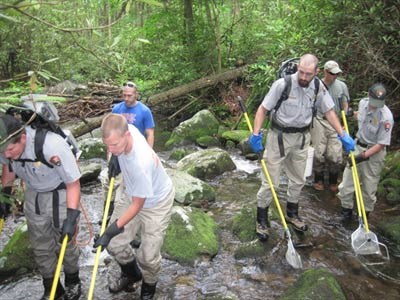
Photo courtesy of Dr. Michelle Connolly, University of Tennessee For decades, researchers have studied the influences of atmospheric deposition (sometimes referred to as "acid rain") on both plants and animals in Great Smoky Mountains National Park. Laboratory analysis by scientists at the University of Tennessee has revealed that trout living in certain high-elevation streams in the park show traces of aluminum deposits gathering in their bone structure that is believed to be linked to atmospheric deposition. Water samples collected during the past 20-years indicate an increase in aluminum deposits in Smokies streams. Scientists have sought to determine whether the increased aluminum found in the water samples of high elevation streams is being absorbed into the tissue of fish. They have discovered that aluminum can be found in the otolith, or "ear bone," of trout. Otolith ring structure is similar to rings on a tree trunk, and can be used to determine age. They also hold a permanent record of various trace elements the fish has been exposed to during its life in the stream. 
In 2011, park biologists and researchers collected trout from three watersheds including the West Prong of the Little Pigeon River, Little River, and the Oconaluftee River. The fish were collected from the same locations used to monitor water quality by the University of Tennessee. Trout were captured using electrofishing techniques and then dissected to remove the otoliths. Those otoliths were then taken to the University of Tennessee where scientists used nitric acid to dissolve the structure enough that it could be viewed using Inductively Coupled Plasma-Atomic Emission Spectrometry (ICP-AES). Scientists discovered that within the same watershed, trout at the highest elevations had greater amounts of aluminum in their otoliths than fish at low elevation. This trend supports water quality data that show greater spikes in aqueous (liquid) aluminum and stream acidity at those elevations, especially during storm events when stream flow increases drastically. A thin soil layer at high elevations and poor buffering capacity to neutralize acidic elements means that more trace elements and metals are washed into the stream without having been neutralized. So what does all this mean? Research indicates that during storm events, the reduced pH in the stream, which increases acidity, is a major stressor to juvenile trout. Proteins, considered the building blocks of life, are damaged when exposed to changes in pH, physical agitation, and/or increased temperature. Thus, when trout are exposed to sudden decreases in pH, their body undergoes extreme stress, which can ultimately lead to death. Research suggests that trout at some high elevation streams have abnormal otolith growth and are more susceptible to the toxic effects of aluminum during early life stages. Studies have shown that aluminum exposure can reduce growth and survival among both rainbow and brook trout at higher elevations. 
Report submitted by Caleb Abramson, Fisheries Technician, Great Smoky Mountains National Park |
Last updated: April 14, 2015
